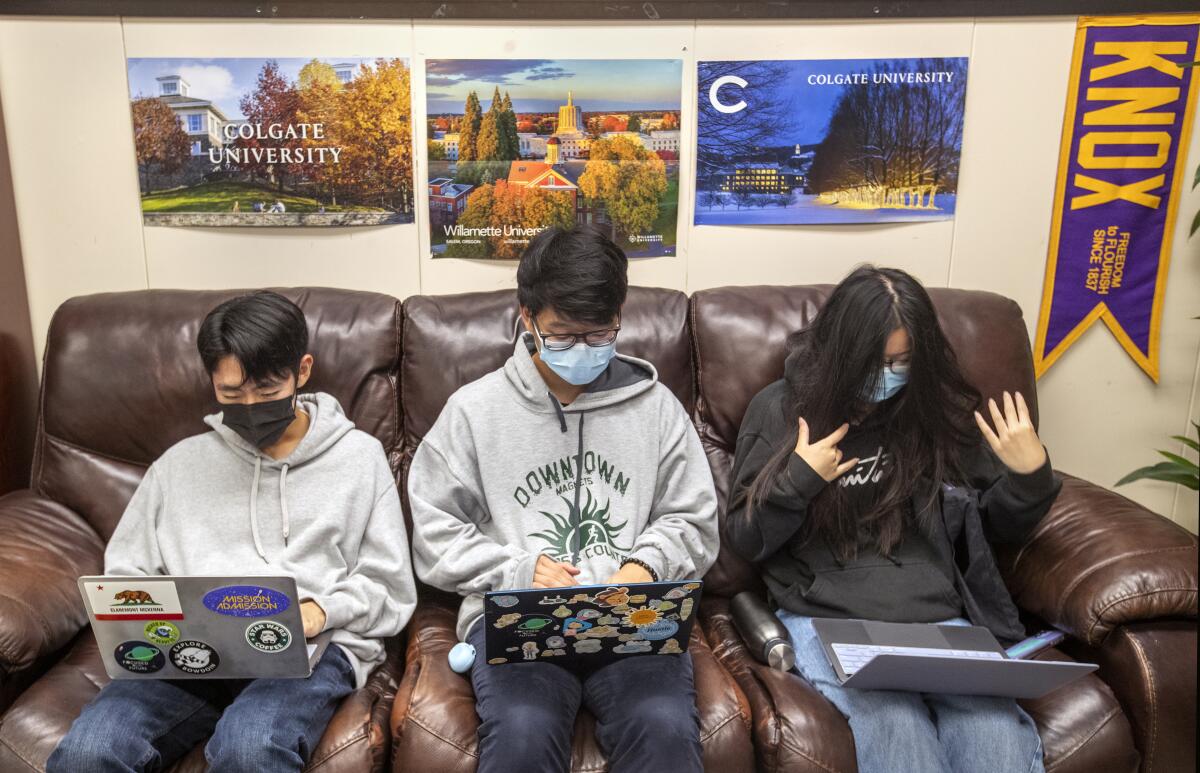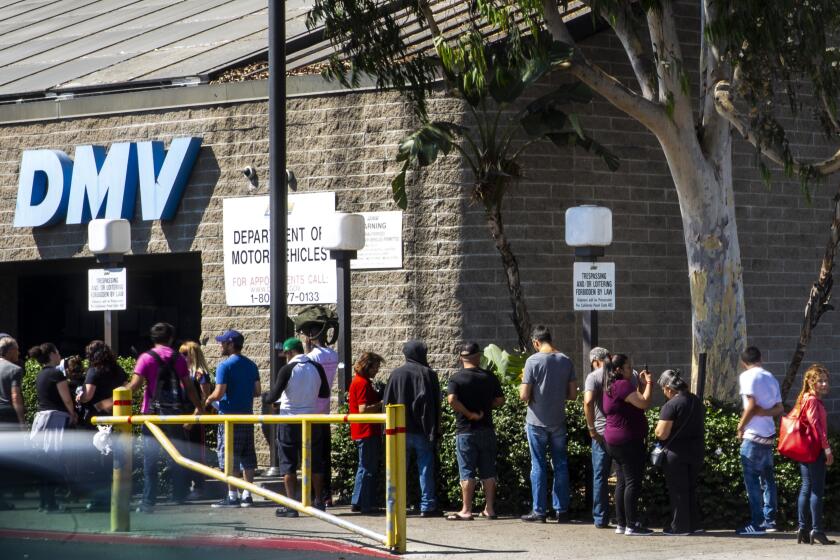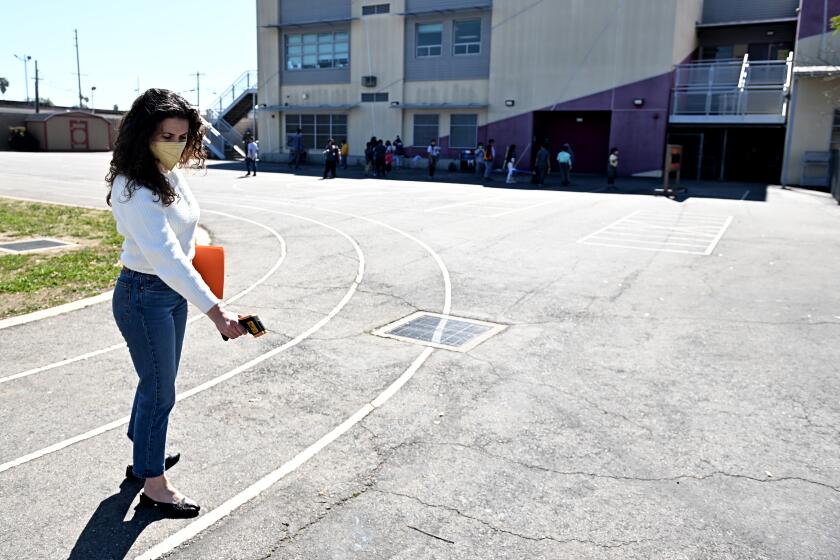Why normalizing failure is vital to equitable grading

This is the Nov. 8, 2021, edition of the 8 to 3 newsletter about school, kids and parenting. Like what you’re reading? Sign up to get it in your inbox every Monday.
In August 2020, L.A. Unified School District directed its middle- and high-school teachers to change the way they had evaluated students since the start of their careers, and do something that countered decades of entrenched grading practices.
In response to a tidal wave of failing grades in those first few months of the COVID-19 pandemic, teachers were told to base their final marks on how much students had learned by the end of the term — the quality of work, not quantity. They were to allow students several extra weeks to make up missed assignments. And poor grades could be raised by retaking tests or rewriting papers. Nearly 15,000 grades improved as a result.
These changes reflect a growing trend in education that asks teachers to shift away from traditional points-driven grading systems in an effort to close yawning academic gaps among racial, ethnic and economic groups, my colleague Paloma Esquivel reports. The pandemic accelerated these disparities, reigniting a debate about the efficacy and accuracy of the grading status quo.
When I first heard of L.A. Unified’s new grading policy, it intuitively made a lot of sense to me. Kids who perform well on a test on the first go, or who routinely turn in assignments on time, often have a leg up. They might have a tutor or a parent at home who can help them with homework. They probably don’t have to work after school or on weekends. (I’m generalizing here, but you get the gist.)
As L.A. Unified’s chief academic officer, Alison Yoshimoto-Towery, told Paloma: “Equitable grading practices align with the understanding that as people we learn at different rates and in different ways and we need multiple opportunities to do so.”
At the same time, I wondered whether such grading policies might insulate kids from failure — which can be elemental to a student’s ability to learn deeply and build resilience.
Research shows that making a mistake and then being corrected is one of the most effective ways to retain new information. “Failure brings you closer to reality. It forces you to strategize and make better decisions next time,” Xiaodong Lin Siegler, a professor of cognitive studies at Columbia University, told me.
I asked Joe Feldman, a former teacher who works with school districts across the U.S. as they reconsider grading policies, how grading might be equitable and allow students to make mistakes.
To fully answer this question, he said, we need to understand how the predominant method of grading came to be, and why it doesn’t work.
The ultimate purpose of grading should be to communicate a student’s level of understanding of the course content to everyone involved: the teacher, the student, the caregivers. But grading practices as we know them today were not built on that premise; they took hold in the mid-20th century, when psychologists B.F. Skinner and John Watson popularized the idea that the most effective way to change a person’s behavior is through positive and negative reinforcement. You may remember their experiments with rats (food pellets, electrified cages) from Psychology 101.
The concept of behaviorism persists in traditional grading; everything students do is rewarded or punished with points. “The problem is that, since the ’70s, we’ve known that extrinsic motivation has been an inferior and inadequate strategy for encouraging critical and creative thinking,” Feldman said.
In fact, if everything a student does is factored into their grade — from homework to in-class exercises to participation — it can have a chilling effect on learning. The classroom becomes a performance space; if a student is not on their A-game 100% of the time, their grades will reflect it. This setup sends a clear message: Do not mess up.
By comparison, equitable grading allows students to retake tests and redo assignments if they don’t get it right the first time, Feldman explained. If they haven’t quite grasped a concept at the start of the term, those mistakes won’t haunt them if they’ve shown improvement by the time report cards are published.
“Think about it — in the professional world, you get redos all the time,” Feldman said. “When you’re late to a meeting at work, it’s not like they dock money from your paycheck. Your boss might ignore it the first time, and then the next there might be a conversation about why you’re showing up late, and the importance of meeting expectations.”
The ever-present possibility for redemption allows students to make mistakes without being penalized. It normalizes failure as an integral part of the learning process. And it instills the notion that one’s intelligence is not fixed, but is instead fluid and can grow with effort and support.
This “growth mindset,” a concept developed by Stanford University psychologist Carol Dweck, begets a love of learning, even when a subject is challenging. Without a paralyzing fear of failure, or the need to get it exactly right on the first go, students can flourish. Research suggests that if people simply believe their brain can grow, they are more likely to experience new and different outcomes. For example, seventh-graders who were taught that intelligence is malleable achieved higher grades in math.
Giving students many chances to master a skill or topic also works in service of equity, Feldman said.
“The students who are making more mistakes (and thus receiving poor marks) are more likely to have fewer resources and intergenerational supports,” he explained. “What we’re trying to do here is level the playing field. We’re actually raising standards, so that no longer can a student get an A just by consistently handing in homework that maybe a tutor helped them with. Now the only way to earn an A or B is to understand the content.”
This also means that disadvantaged students will need extra support to get there. Districts are trying; per L.A. Unified’s new grading policy, students who are failing halfway through a term should receive detailed and clear feedback on where they need to improve, as well as high-dosage tutoring and ample opportunity to replace Ds and Fs.
As Feldman put it: “It doesn’t matter where you start in your learning. It only matters where you finish.”
COVID, COVID ... and un-defunding the police
If you have a child between the ages of 5 and 11, you undoubtedly already know this, but vaccines for that age group began last week. The new vaccine protocol applies to 3.5 million children in California alone. The Times’ Rong-Gong Lin II, Luke Money and Howard Blume say officials hope the new shots will help stave off a potential fifth wave of COVID in California.
California must provide distance learning for disabled students who want it, much as it did during the height of the pandemic, a court ruled. The ruling applies immediately to 15 students, nearly half of them in Los Angeles Unified, but is expected to have wide implications statewide, Howard Blume writes.
Defund the police? Pomona schools tried that. But a school shooting prompted the Board of Education to unanimously reverse course. Times reporter Hayley Smith has the story.
Enjoying this newsletter?
Consider forwarding it to a friend, and support our journalism by becoming a subscriber.
Did you get this newsletter forwarded to you? Sign up here to get it in your inbox every week.
What else we’re reading
A lot of people don’t want their kids exposed to critical race theory and certain books, such as Toni Morrison’s “Beloved.” In an interview, Emily J.M. Knox, the author of “Book Banning in 21st-Century America,” and Terry Moe, a professor of political science at Stanford University, talk about what’s happening, and why. Says Knox: “America is becoming a different place than it was before, and I think that there are a lot of people who do not know how to respond to this.” San Diego Union-Tribune
Being a parent is bad for your quality of life, and maybe for your happiness, some researchers say. Others say the satisfactions of raising kids are deeper and more significant than mere happiness. The Atlantic
If your child is sad, reading a book can be a good way to open up a conversation. Washington Post
“The battle over math pedagogy is a tale as old as multiplication tables.” Another look at California’s new math curriculum. New York Times
The L.A. Recreation and Parks Department opened registration for youth sports last week, bolstered by a $160-million grant from the U.S. Olympic Committee and LA28, the organizing committee for the 2028 Games. LAist
I want to hear from you.
Have feedback? Ideas? Questions? Story tips? Email me. And keep in touch on Twitter.
Start your day right
Sign up for Essential California for news, features and recommendations from the L.A. Times and beyond in your inbox six days a week.
You may occasionally receive promotional content from the Los Angeles Times.




